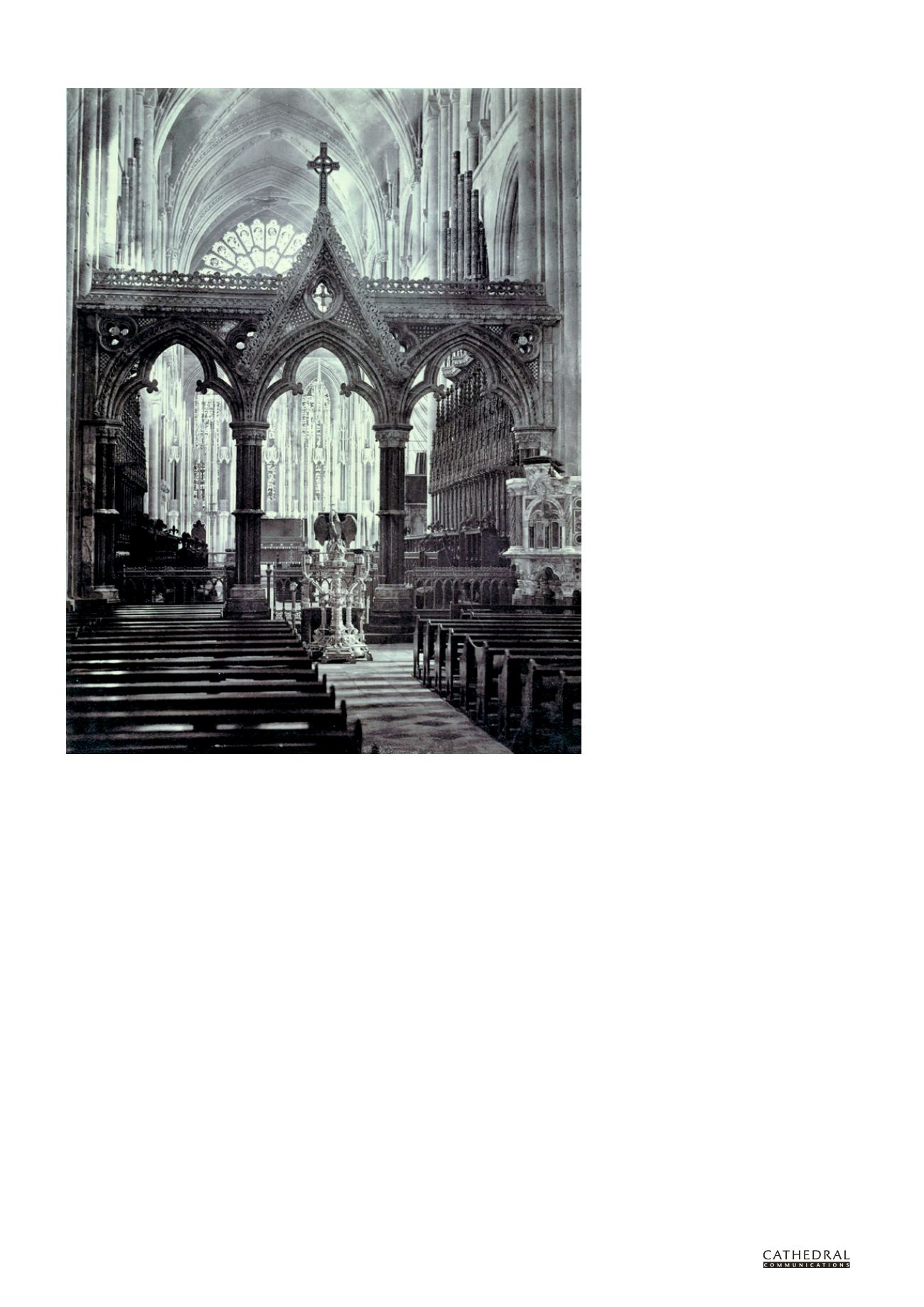

26
BCD SPECIAL REPORT ON
HISTORIC CHURCHES
24
TH ANNUAL EDITION
on the cross washing away the sin of
mankind. It is unsurprising that Puritan
protestants of the 16th and 17th century
regarded such objects as idols. The
pelican lectern at Norwich was buried,
probably to prevent its destruction.
By the late 16th century, few church
wardens regarded the opulence of the
lectern as a fitting support for the Bible.
Of the 100 or so brass lecterns
mentioned in inventories in 1536, less
than half survive today, and many
probably ended up in the melting
pot. Many of these pre-Reformation
lecterns had only recently arrived in
the churches. At Peterborough the
inscriptions on the lectern presented by
the Abbot William Ramsey and Prior
John Malden are illegible today, but they
were recorded in the past and date the
lectern to between 1471 and 1496. At
Wiggenhall St Mary Magdalen, Norfolk
the engravings can be deciphered as
reading
orate pro anima fratris Robti
Bernard gardiani Walsingham anno
Domini 1518
. The one now at Southwell
Minster, recovered from the lake at
Newstead Abbey, is dated 1503 and the
lectern at Lowestoft is dated 1504. Among
the later pre-Reformation lecterns is the
one in Woolpit which dates from 1520.
No attempt was made by the Tudors
to strip church interiors of these objects
of idolatry on a national scale. However,
many church wardens chose to replace
the lavish lectern with a bookstand made
of a humbler material like wood. At Long
Melford, Suffolk, the medieval Rood
Cross was used to fabricate a support for
the English Bible.
The lecterns which survived the big
sell-off during the 16th century became
objects of a witch hunt in the years of
the Civil War and the Commonwealth.
A Puritan rage tried to cleanse the
nation of its blasphemous bookrests,
an unsurpassed iconoclasm smashing
to pieces centuries of religious heritage.
In 1642 troops under the command
of Colonel Sandys destroyed the early
16th-century lectern inside Canterbury
Cathedral. Not far from the bridge at
Cropredy, site of a Civil War battle of
1644, a brass eagle lectern was retrieved
from the river and now sits in the local
church. Whether it was hidden from
Parliamentary troops before the battle
or thrown in by Puritans is unknown.
Similar stories are told across the country,
from Bovey Tracy in Devon to Oundle in
Northamptonshire. Many lecterns were
not recovered until the early 19th century,
an unexpected resurrection after being
buried for centuries.
At Canterbury Cathedral a new
beginning was marked when a brass
eagle lectern was placed in the choir
during the Restoration, made by William
Borroughes of London in 1662. Once
again the brass eagle lectern adorned an
English ecclesiastical space, translated
to the new function and location for
an Anglican liturgy, supporting the
Bible in the English language and
placed in the body of the church.
Further Information
M van der Meulen,
Brass Eagle Lecterns
in England
, Amberley Books,
forthcoming 2017
CC Oman, ‘Medieval Brass Lecterns in
England’,
Archaeological Journal
,
Vol 87, 1930
CC Oman, ‘English Brass Lecterns
from the Seventeenth and
Eighteenth Centuries’,
Archaeological
Journal
, Vol 88, 1931
T Rehren and M Martinón-Torres,
‘Naturam Ars Imitata: European
Brassmaking between Craft and
Science’,
Archaeology, History and
Science: Integrating Approaches
to Ancient Materials
, Left Coast
Press, California, 2008
M de Ruette, ‘Les Lutrins “Anglais”:
Considerations Techniques’,
Actes.
Congrès de la Fédération des
Cercles d’Archéologie et d’Histoire
de Belgique
, Vol 49, 1991
MARCUS VAN DER MEULEN
(marcusvandermeulen@outlook.be)
researches the reactivation of churches as
a preservation strategy and studies church
interiors. He is a member of the Centro Studi
Ghirardacci, Bologna University and a member
of the Future for Religious Heritage Network
Committee. His book
The Brass Eagle Lecterns
of England
will be published later this year.
Interior of Durham Cathedral looking towards the choir in the late 19th century, with Scott and Skidmore’s
pelican lectern in the location for which it was conceived (Source: AD White Architectural Photographs
Collection, 15/5/3090.01048, Cornell University Library)


















